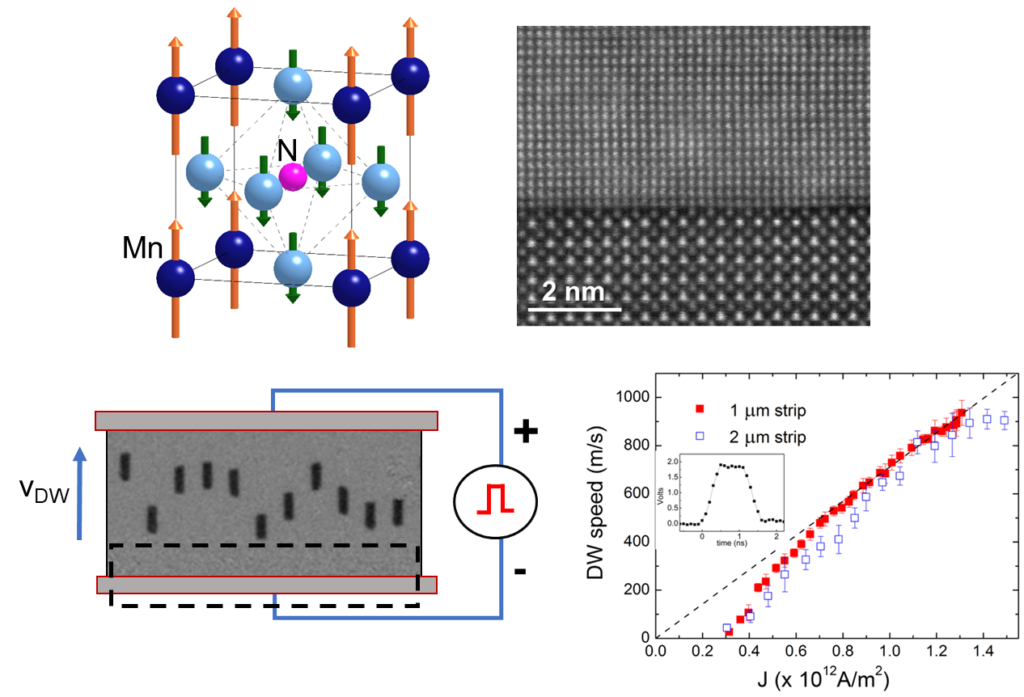We found that Mn4N, a rare-earth free ferrimagnet made of abundant elements, is an exciting candidate for the development of sustainable spintronics devices. This material possess exciting properties, and in particular domain walls can be moved at record speeds by spin-polarized currents, in absence of any external magnetic field. This is explained by the large efficiency of the adiabatic spin transfer torque, due to the conjunction of a reduced magnetization, of the perpendicular anisotropy, and of a large spin polarization.

(Top) Schematic of the atomic structure and Mn magnetic configuration. TEM image. (bottom) Domain wall displacement and deduced domain wall velocity as function of the current pulse.
Tsukuba university has developed the growth by molecular beam epitaxy of X4N thin films, with X=Fe,Ni,Co,Mn. Among this material family, Mn4N ferrimagnetic thin films grown epitaxially on SrTiO3 substrates possess remarkable properties, such as a low magnetization, a perpendicular magnetization, a very high extraordinary Hall angle (2%) and smooth domain walls at the millimeter scale.
We show that in this material record current-driven domain wall velocities can be obtained at room temperature, of nearly 1 km/s. The observed domain wall velocities largely surpass those obtained using spin transfer torques up to now, and are comparable to the best results reported for noncentrosymmetric stacks with interfacial Dzyaloshinskii-Moriya interaction (DMI) favoring chiral Neel walls. The low critical current is a consequence of the Perpendicular Magnetic Anisotropy (PMA) and of the low magnetization of this ferrimagnetic material, which leads to a low barrier for initiating the precession of the DW magnetization. Indeed the structure consist of two Mn sub-lattices antiferromagnetically coupled. The high DW mobility observed in the linear regime is a consequence of the small magnetization and of the high spin polarization. Whereas in the past years the whole spintronics community shifted its focus from spin−transfer torques to spin−orbit torques, these results show that classical spin−transfer torques remain highly competitive for current-induced domain wall (DW) motion and would allow reducing the operating power of memories based on DW displacement. In this article, we also show that the application of gate voltages through the SrTiO3 substrates allows modulating the Mn4N coercive field with a large efficiency. Moreover, Spintronics usually requires cobalt, rare-earth elements, and heavy metals (especially tungsten and platinum). These materials are based on elements identified as critical by the government agencies of developed countries because of the likelihood and impact of supply shortfalls, and of various geopolitical and environmental factors. As Mn4N is made of cheap and abundant elements and does not include critical materials such as precious metals and rare-earths, it appears as a worthy candidate for sustainable spintronics applications.
Team: Spinorbitronics
Collaboration: Tsukuba University (T. Suemasu), Néel Institute (S. Pizzini, J. Vogel)
Funding: ISP project DOMINO (IDEX UGA)
Further reading: Large current driven domain wall mobility and gate tuning of coercivity in ferrimagnetic Mn4N thin films. T. Gushi et al., Nano letters (2019).
Contact: Laurent Vila ( laurent.vila@cea.fr ) and Jean-Philippe Attané ( jean-philippe.attane@cea.fr )




